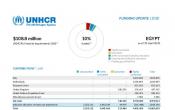Egypt
Operation: Egypt
Location
{"longitude":30,"latitude":27,"zoom_level":0,"iso_codes":"'EGY'"}
By clicking on the icons on the map, additional information is displayed.
The boundaries and names shown and the designations used on this map do not imply official endorsement or acceptance by the United Nations.
Key Figures
| 2020 planning figures | |
| 52,400 | asylum-seekers will be registered on an individual basis |
| 38,300 | refugee and asylum-seeker households will receive multi-purpose cash grants |
| 23,700 | refugee and asylum-seeker households with primary and secondary school aged children will be provided with education grants (47,000 students) |
| 20,000 | substantive status determination decisions will be taken |
| 4,900 | refugees and asylum-seekers will be referred to secondary and tertiary medical care |
| 2018 year-end results | |
| 175,000 | people of concern assisted in seven languages through UNHCR’s information hotlines |
| 152,000 | vulnerable refugees and asylum-seekers received winterization assistance |
| 84,410 | people supported monthly through multi-purpose cash grants to meet basic needs |
| 44,720 | children received UNHCR education grants |
| 1,990 | refugees were resettled to 10 countries |
| 92% | of refugee children were enrolled in primary schools |
Latest Updates
People of Concern
3%
Increase in
2019
2019
| 2019 | 324,740 |
| 2018 | 314,937 |
| 2017 | 289,231 |

[["Refugees",258401],["Asylum-seekers",66335],["Stateless",4]]
Loading ...
Egypt
< Back
2019
{"categories":[2015,2016,2017,2018,2019,2020],"budget":[85.170372352,82.27679034,79.08958703,74.46865337,104.15671601999999,118.31243389],"expenditure":[46.44128458000001,45.61564518,42.6004643,42.82142057,46.118503350000005,null]}
{"categories":[2015,2016,2017,2018,2019,2020],"p1":[85.120372352,82.27679034,79.08958703,74.46865337,104.15671601999999,118.31243389],"p2":[0.05,null,null,null,null,null],"p3":[null,null,null,null,null,null],"p4":[null,null,null,null,null,null]}
{"categories":[2015,2016,2017,2018,2019,2020],"p1":[46.40966352,45.61564518,42.6004643,42.82142057,46.118503350000005,null],"p2":[0.03162106,null,null,null,null,null],"p3":[null,null,null,null,null,null],"p4":[null,null,null,null,null,null]}
Loading ...
CHOOSE A YEAR
- 2014
- 2015
- 2016
- 2017
- 2018
- 2019
- 2020
Year-end Overview
Operational Environment
Egypt is a signatory to the 1951 Refugee Convention and its 1967 Protocol, and the 1969 OAU Convention Governing the Specific Aspects of Refugee Problems in Africa. UNHCR carries out registration, documentation and refugee status determination (RSD) under its 1954 Memorandum of Understanding with the Government of Egypt.The estimated number of people of concern to UNHCR in 2019 stands at 280,000, consisting of refugees and asylum-seekers predominantly from Iraq, Eritrea, Ethiopia, South Sudan, Sudan, Syria and Yemen. Refugees and asylum-seekers live in urban areas alongside local communities.
The protection environment remains conducive. The office is engaged in a dialogue with the Government of Egypt on the management of asylum. The Government provides access to primary and secondary health care to refugees and asylum-seekers of all nationalities at an equal level to Egyptian nationals.
Furthermore, Syrian, Sudanese and Yemeni refugees and asylum-seekers are granted access to public education on the same footing as nationals. However, the significant rise in the cost of living, following Egypt’s economic reforms, has negatively impacted refugees and asylum-seekers, increasing their vulnerability and dependence on assistance.
The Government has been able to prevent any irregular mixed movements from the northern coast of Egypt through the Mediterranean.
UNHCR works closely with the Government and its UN and NGO partners to provide protection and assistance to asylum-seekers and refugees. The refugee response is coordinated through the Inter-Agency Working Group (IAWG) led by UNHCR.
Key priorities
UNHCR’s key priorities for 2019 include preservation of the protection space, enhanced access to asylum, and prevention of refoulement. Focus will be maintained on issues related to registration, access to and release from detention, alternatives to detention, issuance of longer duration residence permits, decentralization of administrative procedures, and regularization of stay. Child protection, youth programmes, prevention of sexual and gender-based violence (SGBV) and protection from sexual exploitation and abuse will continue to be crucial. The Office will remain engaged in the response to mixed movements, and prevention of and response to human trafficking. UNHCR’s engagement with the League of Arab States is expected to continue in 2019, to build on progress made over the past years on protection issues.The overall strategy will be realized in close collaboration with national and international stakeholders, both when leading and coordinating the response, by using the Comprehensive Refugee Response Framework model. In 2019, the Office will continue to ensure the implementation of the 3RP for the Syria crisis and the Egypt Appeal for Asylum Seekers and Refugees from Sub-Saharan Africa, Iraq and Yemen, in close coordination with UN and NGO partners.

















